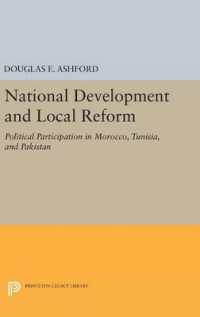- ホーム
- > 洋書
- > 英文書
- > Politics / International Relations
Full Description
How to develop new forms of political expression and political participation on the national level is one of the major problems facing newly independent countries. Mr. Ashford gives a careful description of the pattern of Moroccan national politics at the time of independence, and analyzes how this pattern was changed during the first three post-independence years. He provides a general outline of the ways a widely differentiated people can participate in the national politics of a developing country. Like Apter's books on Ghana and Uganda, and Wriggins' book on Ceylon, this is an important study of the transition to independence of a postwar, rapidly developing political system. Originally published in 1961. The Princeton Legacy Library uses the latest print-on-demand technology to again make available previously out-of-print books from the distinguished backlist of Princeton University Press. These editions preserve the original texts of these important books while presenting them in durable paperback and hardcover editions.
The goal of the Princeton Legacy Library is to vastly increase access to the rich scholarly heritage found in the thousands of books published by Princeton University Press since its founding in 1905.
Contents
*Frontmatter, pg. i*ACKNOWLEDGMENTS, pg. vii*CONTENTS, pg. ix*TABLES, pg. xi*CHAPTER I. INTRODUCTION, pg. 1*CHAPTER II. BACKGROUND TO MOROCCAN NATIONALISM, pg. 25*CHAPTER III. ORGANIZING THE ISTIQLAL AND ACHIEVING INDEPENDENCE, pg. 57*CHAPTER IV. GOVERNMENT AND ADMINISTRATION, pg. 93*CHAPTER V. CITIZENS AND PRIVILEGES, pg. 132*CHAPTER VI. VIOLENCE AND COERCION, pg. 157*CHAPTER VII. RURAL ADMINISTRATION AND THE TRIBES, pg. 185*CHAPTER VIII. INDEPENDENCE AND THE ISTIQLAL, pg. 219*CHAPTER IX. THE MOROCCAN LABOR MOVEMENT, pg. 270*CHAPTER X. OPPOSITION POLITICAL PARTIES, pg. 302*CHAPTER XI. DEVELOPMENT OF REPRESENTATIVE GOVERNMENT, pg. 344*CHAPTER XII. FORMATION OF INTEREST GROUPS, pg. 373*CHAPTER XIII. CONCLUSION, pg. 405*BIBLIOGRAPHICAL NOTES, pg. 419*INDEX, pg. 423








